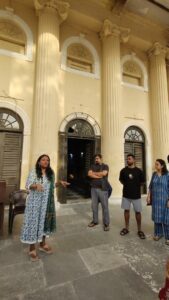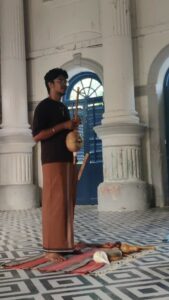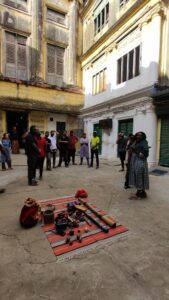A recent heritage trail in Chennai took participants on a journey through the city's diverse musical heritage.

The journey commenced at the stately Memorial Hall, George Town. (Roshne Balasubramanian/SouthFirst)
Six years have passed since Chennai’s inclusion in UNESCO’s Creative Cities Network — an honour that has ignited a profound sense of pride among Chennaiites. Yet, this pride often finds itself confined within the precincts of familiar-mainstream musical traditions.
It inadvertently disregards the expansive panorama of the city’s collective musical heritage. However, at the heart of this recognition lies Chennai’s intricate musical legacy — a saga woven across centuries.
As a tribute to this opulent heritage, Tamil Nadu Tourism Development Corporation (TTDC), in synergy with Nam Veedu Nam Oor Nam Kadhai (NVNONK) and The Madras Commune, conducted “Isaiyum Varalarum” — an immersive musical heritage trail that took centre stage on a serene Sunday morning.
The event brought together a motley group of participants — heritage enthusiasts, film industry members, artistes, cultural institute directors, and storytellers too.
The journey commenced at the stately Memorial Hall, an architectural gem nestled along the enchanting Evening Bazaar Road within the historical neighbourhood of George Town.

Thirupurasundari Sevvel of Nam Veedu shared her sentiments against the backdrop of the time-honoured building’s architecture. (Roshne Balasubramanian/SouthFirst)
Thirupurasundari Sevvel of Nam Veedu shared her sentiments against the backdrop of the time-honoured building.
“This building, reminiscent of Greek grandeur, was erected in the 1800s by the British. It was a gesture of gratitude to the gods after the tumultuous Sepoy Mutiny,” she began, setting the historical context.
Stepping inside the hall, the acoustics immediately caught our attention.
“The Memorial Hall was designed to host a variety of events. In our modern era, it’s crucial to consider how we can breathe life into these heritage structures — perhaps by curating such musical events. The acoustics within are nothing short of brilliance,” she expressed, highlighting the hall’s potential.
“Isaiyum Varalarum” is part of the many guided walks arranged by NVNONK.
“As we discuss music heritage, certain imagery tends to dominate our thoughts — the December kutcheri season or film music. While these aspects hold undeniable significance, Chennai’s musical essence transcends these confines. In the 1960s and ’70s, numerous musicians graced the streets with their performances, including the maestro Ilaiyaraaja. ‘Isaiyum Varalarum’ serves as a portal to unveil these concealed dimensions,” she eloquently articulated, inaugurating the trail.
Among the performers, the spotlight was on Manikandan, affectionately known as Sound Mani — an artiste, researcher, and sound engineer dedicated to reviving lesser-known native instruments.

Sound Mani’s nimble fingers effortlessly danced across instruments like the parai, kinnera and magudi. (Roshne Balasubramanian/SouthFirst)
Jyothi K, an artiste adorned with unique abilities — an ambassador of art beyond sight — cast an enchanting spell upon the diverse audience.
As Mani’s nimble fingers effortlessly danced across instruments like the parai, kinnera, magudi, and the resonant sangu (conch), he declared, “Music is medicine.”
The protracted 14-second echo of the conch in the hall resonated not merely as an announcement of the beginning but as a tribute to history.
Each instrument, meticulously crafted from sustainable resources like gourds and plant fibres, carries within its frame a rich history of cultural legacy and therapeutic benefits.
In a harmonious yet contrasting interlude, Jyothi’s violin commenced its serenade, breathing life into the air.
Her performance interwove an Armenian melody, a subtle reminder of Chennai’s connection with distant lands, along with tunes from the iconic 1960s Tamil cinema.
Soon, the setting shifted to the historic Pachaiyappa’s Higher Secondary School on NSC Bose Road.

Participants at the Pachaiyappa’s Higher Secondary School on NSC Bose Road. (Roshne Balasubramanian/SouthFirst)
Here, ensconced within the verandah’s history-soaked embrace, eyes shut, the audience was enveloped in Sound Mani’s musical storytelling — a portal to sylvan landscapes through the resonance of his melodies.
However, the event surpassed its own intended purpose, acting as a bridge between the past and present.
Attendees were magically transported to mystical forest realms, serenaded by the enchanting chorus of croaking frogs, the melodious trill of bird calls, and the rhythmic symphony of rain — each note brought to life by the indigenous instruments that Mani owned and masterfully played.
“This is the first time I am attending something as unique as this. It has truly been an unforgettable experience,” shared Prasanna, a participant.
“I am new to Chennai and was eager to explore. Being a history enthusiast, this event drew me in. Many of these instruments were new to me and being able to connect what I read in books to a tangible experience was truly remarkable,” said Balaji, another participant, reflecting on his experience.
Art and music, the conduits of raw emotion, transcend the mere realm of aesthetics. As unwavering agents of transformation, they hold the power to shape and reshape society. “Their accessibility — an inherent human right — transcends the boundaries of socio-economic disparities,” Mani emphasised.
Sound Mani’s skillful rendition of the parai, an emblem deeply entrenched in the city’s heritage, serves to fortify this conviction.
“This is the fifth ‘Isaiyum Varalarum’ trail organised by NVNONK since 2019 (the first in collaboration with TTDC and the second with The Madras Commune). However, the idea for such a trail originated from the ‘Pedestrian Possibilities’ event held in 2015, where artiste Prem John played songs on the street for the public. We aim to organise these music trails once in three months,” Thirupurasundari shared.
The fundamental concept, she said, is to blend heritage spaces with artistes’ performances.
The entirety of the proceeds generated from these trails are channelled towards the support of the performing artistes.
“It’s well-known that the city boasts a rich artistic heritage. But it’s vital to support today’s artistes, and their works; to encourage and nurture them. Only then can this legacy be taken forward,” said Thirupurasundari.
“Isaiyum Varalarum” emerges as a perpetual reminder of the intricate interplay of art and music as ageless catalysts for transformation. It encapsulates the very essence of the city’s soulful symphony across the epochs.
To be part of Chennai’s heritage trails, visit Instagram @TTDCofficial @namveedu_namoor_namkadhai

May 11, 2024

May 11, 2024

May 11, 2024

May 10, 2024

May 10, 2024

May 10, 2024